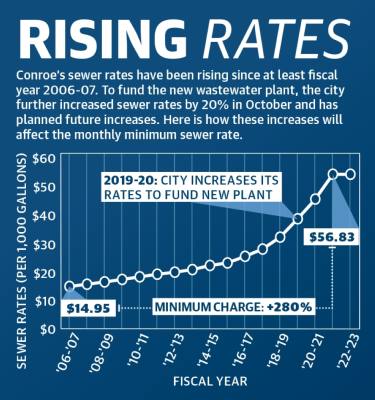The city of Conroe broke ground on its new wastewater treatment plant Dec. 2—a $60 million project that will come online in spring 2022. The plant is permitted to treat 6 million gallons a day but is expandable to 12 million gallons a day to serve Conroe’s rapid growth, city officials said.
The new plant, designed by Lockwood, Andrews & Newnam and constructed by LEM Construction, sits on a 25-acre site east of I-45 and north of South Loop 336. It will serve the city’s area east of I-45, while the city’s existing plant, located on Sgt. Ed Holcomb Boulevard, will serve the western half.
The new plant will also lessen the load on the existing plant—which is nearing maximum capacity—while also using energy-saving technologies, officials said.
“It’s going to be more efficient than [our current plant],” said Greg Hall, superintendent of both wastewater plants. “We try to be as minimalistic as we can.”
To fund the plant, the city increased sewer rates by 20% in October and has planned increases for the next two years of around the same percentage, Assistant City Administrator Steve Williams said. Although Conroe’s rates have been steadily rising for over a decade, city officials said the rate increases are necessary to fund Conroe’s infrastructure needs.
“We are growing as a city ... and we are already nearing capacity at our older wastewater treatment plant,” City Council Member Raymond McDonald said. “[The new one] should serve us for quite a while.”
Room for growth
State law mandates that when a sewage treatment plant reaches 75% of its permitted average daily or annual flow for three consecutive months, the permittee must begin planning for its expansion or upgrade, said Norman McGuire, the director of public works for the city of Conroe.
In 2016, Conroe’s existing plant—which was built in phases between 1970 and the 1990s—was operating at 85% capacity, pumping 8.5 million gallons per day with a capacity of 10 million gallons per day, McGuire said. The city’s request for an upgrade to a 12 million-gallon capacity discharge was approved, and it now operates at 70% capacity, he said.
“We were able to add time and lessen the time constraint requirements ... by successfully requesting a 12 million-gallons-per-day discharge,” McGuire said.
Still, with Conroe’s rapid growth—the city’s population jumped 61% from 2013-18, according to five-year estimates from the U.S. Census Bureau—and land capacity limitations at the current plant, city officials began designing the new facility in late 2015 to plan ahead, McGuire said.
“If Conroe did not invest in a new facility, the growth of Conroe would have to be slowed and restricted,” he said.
Conroe’s new plant will treat 4 million gallons per day but is permitted for up to 6 million gallons and is expandable in the future for 12 million gallons, Hall said.
The new plant’s location was not chosen based on specific pockets of population growth but rather so it could intercept Conroe’s existing sewer line, therefore saving the city money, Hall said.
Melissa Mack, project manager and senior associate of Lockwood, Andrews & Newnam, said Conroe purchased enough property to handle future increased wastewater flows coming into the facility.
The new plant is also designed for future installation of carbon diversion measures, or technologies that limit carbon emissions, meaning energy savings for Conroe, Mack said.
Conroe also treats a small portion of wastewater from the city of Willis, and the new plant will continue to service Willis, Hall said. The city of Willis is also constructing its own $5.75 million wastewater treatment plant, which broke ground in April 2019 and is expected to come online in September 2020, said Taylor Whichard, director of public works for the city of Willis.
The plant is being funded through a bond, Whichard said.
Rate increases
Construction is being funded with bonds that will be paid back from a portion of customers’ water and sewer bills, Williams said. The bonds for the project were sold in 2018 and will be paid over a 20-year period.
The city increased sewer rates for fiscal year 2019-20 by 20% to fund the new wastewater plant, reaching a minimum charge of $38.83 per 1,000 gallons of wastewater treated monthly. Rates are tiered, so generally the more water is used, the higher the charge. Annual proposed rate increases to fund the new plant are 21% for FY 2020-21 and FY 2021-22 and 2% for FY 2025-26 and FY 2027-28.
Prior to this increase, the city has been raising its water and sewer rates each year since at least FY 2006-07, according to city financial reports. In FY 2006-07, Conroe’s minimum sewer rate was $14.95 per 1,000 gallons. By FY 2018-19, the rate had more than doubled to $32.36 per 1,000 gallons. Based on the projected rate increases given by the city, the minimum charge per 1,000 gallons is expected to be $59.15 per 1,000 gallons by FY 2027-28.
“Right now, we are on the front lead of one of the most expensive sewer costs out there,” McDonald said. “I don’t like that. I think it looks bad for our city.”
Hidden Creek resident Samantha Coppolo said she has lived in Conroe for eight years and is dismayed with her rising rates.
“It is very frustrating,” she said. “They are basically taxing/billing us out of our home. It’s getting so expensive to live here, and they just keep building.”
McDonald said he is concerned with how rapidly the rates are increasing, but because the city uses only sewer and water fees—not property taxes or other taxes—to cover sewer and water costs, it is limited in funding options for the new plant.
“It is expensive, and I get people’s concerns of the raises,” he said. “[But] we’re growing ... so we have to think ahead.”







